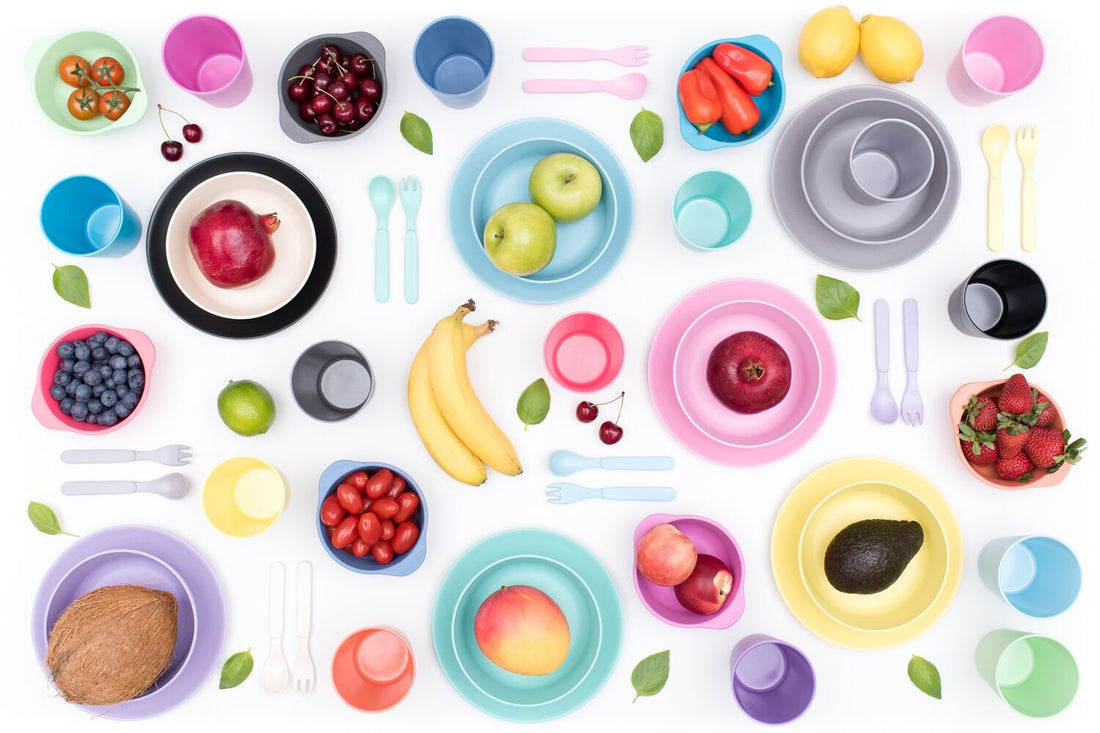
Ditch the plastic is my new weekly blog series where I’ll be going through the most common plastic products and highlighting the reasons why we should be ditching them for good, (it’s really easier then you think!) I’ll also be including safer alternatives and then to finish a favourite product in each post.
To kick off my “ Ditch the plastic ” blog series I have decided to start with dinnerware, for both adults and children!
Plastic, simply put, is substances or materials that can be easily shaped or moulded, and has become widely available due to its low cost and being easy to make, although there are health risks that many aren’t aware of that come with buying all plastic products, and in this post I’m going to go through dinner plates, bowls, cutlery and cups/mugs.
The most common ingredient in plastic products you may have already heard of is BPA, which stands for bisphenol A. Basically companies will add BPA to plastic products to make them more durable, and have been doing so since around the 1960’s, but recent studies have shown the negative effects of BPA which has been known to seep into our food from the plates/bowls or plastic packaging or wraps.
Now days luckily you can find a bunch of water bottles, dinnerware, food storage containers, even baby bottles that will be BPA free. However, unfortunately BPA isn’t the only chemical that we need to worry about in plastic products. Phthalates is the other leading chemical most companies now advertise as “free from” just one of the reasons why, (including BPA) are being taken out is they have been linked to interfere with how our bodies produce oestrogen, are being linked to certain birth defects, among other health concerns. Which is pretty scary when you think about it, the plastic plates that your putting your healthy, even organic dinner on could potentially be harming you. Melamine is another chemical added to plastic that poses health risks to us, high exposure to Melamine can increase your chances of kidney stones and kidney failure, and they are most commonly used for children’s dinnerware because they are extremely durable, basically crack proof and have a smooth texture.
Most commonly the chemicals in our plastic dinnerware seep into our food is when they are heated up, in the microwave or when very hot food is placed on top. So never microwave food on plastic plates/bowls, even if they are microwave safe. So it’s important to know that even though your plates are listed, BPA and Phthalates free, there are many more chemicals inside and they are still a dangerous health risk and because every plastic product is different, it would be nearly impossible to list all the ingredients to avoid. So it’s just safer to ditch them all together!
But not only is plastic harmful to humans, it’s also doing a number on our planet! It can take plastic 450 years to fully decompose, yes you really did read that right, four hundred and fifty years!! Even more reason why we should avoid plastic, and why recycling is so important! (I could go on and on about recycling but I’ll leave that for a separate post!
There are tones of safer alternatives to plastic dinnerware, such as –
Ceramic plates, (although some may contain chemicals in printed designs/patterns so always do your research before buying.) Etsy have a lot of handmade bowls/plates ect which is great because I always try to encourage everyone to shop small.
Coconut bowls, they are made from real coconut shells and are available through many health food shops and online.
Silicone cups and bowls, they are hard to break, easy to clean and safe for toddlers and babies
Tempered glass, now I know it’s honestly a parents worst nightmare even thinking of giving a toddler anything made of glass, but tempered glass is twice as strong as normal glass and there are lots of safe ways to monitor and teach your kids to be careful around glass. There are lots of brands now providing glass bottles for formula/expressed breastmilk aswell.
Stainless steel is also a really great alternative and now days comes in bowls, plates and water bottles, its also very hygienic and durable, they also make really great lunch boxes but can be a little more expensive.
Wood, easy, safe and readily available through most online health food shops.
And my favourite alternative to plastic is bamboo. Bamboo is really a wonderful little plant! It’s 100% biodegradable, so strong and durable when growing so it needs very little water and no pesticides and are fully scratch resistant. Bamboo is fully mature in 5 years, making it the top of the most sustainable resource list! It’s practical and stylish!
And my favourite plastic free alternative bamboo dinner sets are the bobo and boo sets! They are perfect to replace your children’s plastic plates, bowls, cutlery and cups with, come in a really great colour selection and are fully Australian owned!
A full review will be coming soon, so keep an eye out! Available to buy from http://www.boboandboo.com.au
Thank you for reading, and I hope you enjoyed the first in my new series, and this inspires you to “ ditch the plastic ” (haha, see what I did there?)
Feel free to comment your plastic free alternatives for dinnerware below and stay tuned for more ditch the plastic posts!
Guest blog by Nichole, The Natural Mumma
Nichole is a single mum from Melbourne with a passion for green living, organic & natural products, healthy meal ideas & holistic parenting.
You can follow her blogs on instagram @the.naturalmumma or via http://thenaturalmumma.com





